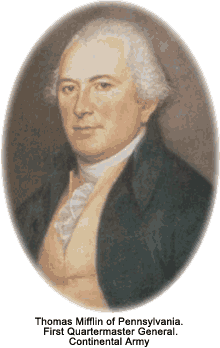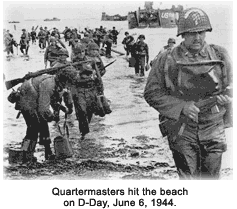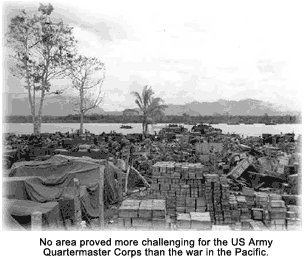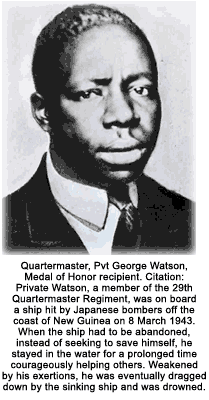Derived from the old French quartier and the latin quartaurius, quartermaster means master of quarters; one who goes ahead to provide lodging or quarters for those who are to follow.
 The Quartermaster Corps traces its origins to June 16, 1775. Following General Washington’s address accepting command of the Continental Army, the Second Continental Congress passed a resolution "providing one Quartermaster General" of the grand army and one deputy under him for a separate army. Major General Thomas Mifflin, a 32-year-old Philadelphia merchant, was the first known quartermaster general.
The Quartermaster Corps traces its origins to June 16, 1775. Following General Washington’s address accepting command of the Continental Army, the Second Continental Congress passed a resolution "providing one Quartermaster General" of the grand army and one deputy under him for a separate army. Major General Thomas Mifflin, a 32-year-old Philadelphia merchant, was the first known quartermaster general.
The surprise Japanese attack on Pearl Harbor in December 1941 put the nation at war for the second time in just over two decades. World War II spawned combat all over the globe in multiple theaters of operation. The U.S. Army Quartermaster Corps was responsible for procuring and delivering various supplies to units in all those theaters. No other area proved to be more challenging than the war in the Pacific Theater with its lengthy supply lines.
Needed were masses of trained personnel with purchasing, inspection and supply-management skills, coupled with effective administrative procedures and inventory techniques. More than 32,000 officers, officer cadets and key enlisted personnel received their training at the Quartermaster School between July 1, 1940 and December 3, 1945. The physical conditioning of entrants was emphasized from the beginning of the training program. In addition, the rigorous military training entailed learning to use all armed methods of protection, crawling through simulated battlefields, taking refuge in foxholes (of their own digging), making technical decisions regarding rations, and learning every aspect of ammunition supply points (ASPs). The demanding course was not entered into lightly: eleven weeks of academic training and six weeks of field maneuvers, plus military training in the midst of war lay ahead for the recruit.
The Quartermaster Officer Candidate Schools strongly emphasized that quality and individual attention be given to each student during training. Criteria for entry were based upon personality, potential leadership, alertness, and attitude. The courses were attended by officers from several foreign countries: Great Britain, Canada, the Philippines, China, Mexico, Peru, Venezuela, and Brazil, as well as other Latin American countries.
The Quartermaster School instructors were carefully chosen and trained. Their courses addressed such subjects as approved army methods, proper use of visual aids, testing and measuring devices, platform mannerisms, voice control, lesson planning, questioning techniques and motivation skills related to teaching others. Subject to criticism, students were required to conduct practice-teaching instruction. Teaching large numbers of servicemen, in the shortest possible time, proved to be a difficult task.
 The first step in the Quartermasters' duties was procurement, which required more than simply calculating user needs and filling out the correct requisitions. Overcoming numerous hurdles, corpsmen were responsible for making victory possible. Their obstacles started on the home front, where shortages of all basic supplies originated. Further complicating matters was the fact that manufacturing and agricultural production had to be increased immediately.
The first step in the Quartermasters' duties was procurement, which required more than simply calculating user needs and filling out the correct requisitions. Overcoming numerous hurdles, corpsmen were responsible for making victory possible. Their obstacles started on the home front, where shortages of all basic supplies originated. Further complicating matters was the fact that manufacturing and agricultural production had to be increased immediately.
Quartermaster corpsmen provided Class I, II, III and IV items to the war front.
Class I: Food
A steady supply of food and rations was most vital to the survival of the far-flung armed forces. During much of the war the Pacific Theater experienced heavy losses of food, resulting in random cycles of "feast and famine." Food losses stemmed from a number of sources, the first being storage problems. Limited warehousing was available, and Class I items shipped to the Pacific were often stacked in big open food dumps with little protection from the elements. To rectify that problem, the corpsmen created portable warehouses called "Paulin Oases," which resembled a native hut called a bures.
Packaging problems were extremely challenging because food supplies were roughly handled, dropped from airplanes, sling-loaded and dumped into huge cargo holds — causing tremendous losses. Back in the United States, the Office of the Quartermaster General worked closely with private manufacturers to come up with more durable and resilient outer packaging. Quartermaster receiving and distributing (R&D) specialists worked on producing moisture- and insect-resistant paper sacks for the various food products.
 Distribution problems were next on the list and proved to be the most difficult. The problem of getting food into the hands of front-line troops meant dealing with primitive road conditions, mountainous terrain and inevitable enemy action — all within a timely manner. The R & D specialists developed a simpler plan to meet the specialized needs and unique requirements of the fighting troops.
Distribution problems were next on the list and proved to be the most difficult. The problem of getting food into the hands of front-line troops meant dealing with primitive road conditions, mountainous terrain and inevitable enemy action — all within a timely manner. The R & D specialists developed a simpler plan to meet the specialized needs and unique requirements of the fighting troops.
The A-ration, fresh food; and B-ration, canned food, needed to be cooked — not always possible in combat situations. The C-ration (for combat duty), comparable to picnic food, was the first individually packaged meal for the American soldier, which was easy to carry and could be prepared by the soldier himself. K-rations were high-energy chocolate bars, used only in emergencies.
Class II: Clothing
Quartermasters in the Pacific had trouble getting sufficient reserves of clothing where it was needed, mainly because the U.S. clothing and textile industry could not easily obtain the necessary raw goods from scarce commodities. In addition, sometimes plants had to be completely retooled to accommodate full-scale production. Clothing took a lower priority compared to food and petroleum products. After the clothing did arrive, it usually went into base storage areas — sometimes disintegrating as a result of devastating environmental effects.
Class III: Petroleum Products
Essential to the war effort were gasoline, kerosene, aviation fuel, diesel oil, fuel oil and petroleum-based lubricants. Critical for the sustainment of war machinery and more vital even than clothing and general supplies, those Quartermaster supply items took high priority. The corpsmen excelled in the processing and delivery efforts, and because of easy accessibility from Australia, it suffered fewer hazards. Problems existed with the storage and distribution of 55-gallon drums. Heavy and bulky, they defied easy handling, but the Quartermaster efforts to furnish Class III supplies were judged to be an overall success.
Class IV: General Supplies
Such diverse items as rope, soap, candles, knives, forks and spoons rarely warranted "life or death" status. Those Class IV items usually shipped on a restricted basis. A procurement problem on the home front — the inability of the manufacturers to meet demand with supply — was the main reason for delays.
 Time after time, Quartermaster supply personnel demonstrated the "whatever works" approach and diligently pulled it off. They successfully maintained higher stock levels, ran stand-alone distribution centers, worked 24-hour shifts and performed multiple tasks, going beyond the call of duty. Faced with extremely unusual circumstances, plus finding that they often lacked basic items or equipment, the Quartermasters in the Pacific improvised and became known as "QM Imps." They effectively carried out supply operations through careful planning, and lessons learned from previous assaults on the enemy.
Time after time, Quartermaster supply personnel demonstrated the "whatever works" approach and diligently pulled it off. They successfully maintained higher stock levels, ran stand-alone distribution centers, worked 24-hour shifts and performed multiple tasks, going beyond the call of duty. Faced with extremely unusual circumstances, plus finding that they often lacked basic items or equipment, the Quartermasters in the Pacific improvised and became known as "QM Imps." They effectively carried out supply operations through careful planning, and lessons learned from previous assaults on the enemy.
The Quartermaster Corps trained thousands of soldiers during World War II, filling specialized roles in every theater of operation from the Pacific and China-Burma-India theaters to North Africa, Italy, central and northern Europe. They willingly supplied more than 70,000 different items with more than 24 million meals each day going to the servicemen. They also incorporated the help of K-9 Corps with 15 platoons serving overseas during World War II. The dogs were used to detect the enemy's presence, transfer messages, and detect mines.
Using strategic anticipation and successful island-hopping techniques, the Quartermaster corpsmen accomplished what they had set out to do, making ultimate victory possible. When the war was over, the Quartermaster Corps had recovered and buried nearly 250,000 soldiers in their temporary cemeteries all over the world. The Quartermaster Corps lost 4,943 soldiers in World War II. They applied every conceivable means available to distribute essential supplies to the servicemen, often at the ultimate cost.